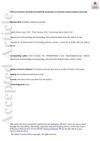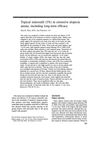TLDR There is no cure for alopecia areata, and treatment success depends on the individual's situation.
As of 2015, there was no cure for alopecia areata (AA), an autoimmune disease causing nonscarring hair loss in both children and adults. Treatment success varied depending on factors such as disease duration, activity, patient age, and extent of hair loss. While patchy and limited cases were relatively easy to manage, extensive scalp and body hair loss presented a significant challenge. Physicians typically selected a cost-effective treatment approach based on these factors. The document reviewed the clinical presentation, epidemiology, pathophysiology, and current and evolving treatments for AA.
 1 citations
,
August 2022 in “JAAD case reports”
1 citations
,
August 2022 in “JAAD case reports” Tofacitinib and oral minoxidil may help treat Sisaipho alopecia areata.
 1 citations
,
October 2020 in “Journal of Cosmetic Dermatology”
1 citations
,
October 2020 in “Journal of Cosmetic Dermatology” Using minoxidil and tofacitinib together can effectively treat severe hair loss.
 6 citations
,
July 2019 in “Indian Journal of Dermatology”
6 citations
,
July 2019 in “Indian Journal of Dermatology” About 12% of children in Kota, Rajasthan, experience hair loss, mainly due to fungal infections, with early treatment advised to prevent worsening.
September 2014 in “DOAJ (DOAJ: Directory of Open Access Journals)” Rosemary is as effective as Minoxidil for treating alopecia areata.
 109 citations
,
May 2011 in “Dermatologic Therapy”
109 citations
,
May 2011 in “Dermatologic Therapy” Alopecia areata is a type of hair loss that can lead to complete baldness, often associated with other autoimmune conditions, and half of the cases may see hair return within a year.
 54 citations
,
March 1987 in “Journal of The American Academy of Dermatology”
54 citations
,
March 1987 in “Journal of The American Academy of Dermatology” 3% topical minoxidil effectively treats extensive alopecia areata with few side effects.






